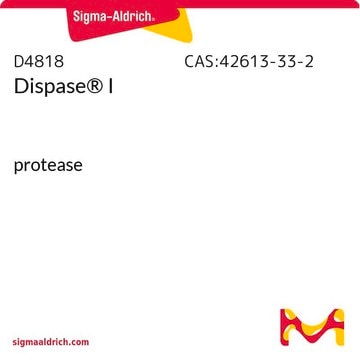SCM133
PluriSTEM® Dispase-II Solution
Dispase-II has proven to be a rapid and effective, yet gentle, agent for separating many tissues and cells grown in vitro.
Synonym(s):
Dispase, Dispase 2
About This Item
Recommended Products
Quality Level
form
liquid
manufacturer/tradename
PluriSTEM®
concentration
1 mg/mL in sterile DMEM/F-12
technique(s)
cell culture | mammalian: suitable
cell culture | stem cell: suitable
shipped in
dry ice
General description
PluriSTEM Dispase-II has been validated to work alongside PluriSTEM Human ES/iPS Medium (SCM130) for the culture and passage of human embryonic and induced pluripotent stem cells.
Dispase-II enzyme is produced in Bacillus polymyxa.
Application
1. Coat 6-well plates with 1:20 Matrigel coating (1.5 ml per well). Incubate at 2-8ºC overnight or coat at RT for at least 30 minutes to 1 hour before use.
2. Remove matrigel coating. Add 2 mL of Complete Media per well.
3. Remove areas of differentiation within culture.
4. Aspirate media.
5. Wash once with 2 mL PBS.
6. Add 1.5 mL Dispase II per well. Incubate for 37ºC for 7 minutes.
7. Wash 2X with 2 mL PBS, w/o Mg and Ca.
8. Add 2 mL Complete Media to each well and use cell scraper to detach colonies.
9. Collect scrapped cells in 15 ml conical tube.
10. Spin 800 rpm for 5 minutes
11. Resuspend in appropriate volume of complete media. Typical splitting ratio is 1:5 – 1:6 depending upon cell density. Cells should be ready for passaging in 5-6 days time using PluriSTEM Human ES/iPS Medium.
Stem Cell Research
Enzymes & Biochemistry
Quality
Physical form
Dispase-II enzyme is produced in Bacillus polymyxa.
Storage and Stability
Legal Information
Disclaimer
Storage Class Code
10 - Combustible liquids
WGK
WGK 1
Flash Point(F)
Not applicable
Flash Point(C)
Not applicable
Certificates of Analysis (COA)
Search for Certificates of Analysis (COA) by entering the products Lot/Batch Number. Lot and Batch Numbers can be found on a product’s label following the words ‘Lot’ or ‘Batch’.
Already Own This Product?
Find documentation for the products that you have recently purchased in the Document Library.
Customers Also Viewed
Articles
Skip weekend feedings. Defined serum-free and feeder-free expansion media for human pluripotent stem cells (ES and iPS cells). See publications and protocols.
Skip weekend feedings. Defined serum-free and feeder-free expansion media for human pluripotent stem cells (ES and iPS cells). See publications and protocols.
Skip weekend feedings. Defined serum-free and feeder-free expansion media for human pluripotent stem cells (ES and iPS cells). See publications and protocols.
Skip weekend feedings. Defined serum-free and feeder-free expansion media for human pluripotent stem cells (ES and iPS cells). See publications and protocols.
Protocols
Stem cell reprogramming protocols to generate human induced pluripotent stem cells (iPSCs) including viral and non-viral RNA based methods.
Our team of scientists has experience in all areas of research including Life Science, Material Science, Chemical Synthesis, Chromatography, Analytical and many others.
Contact Technical Service














